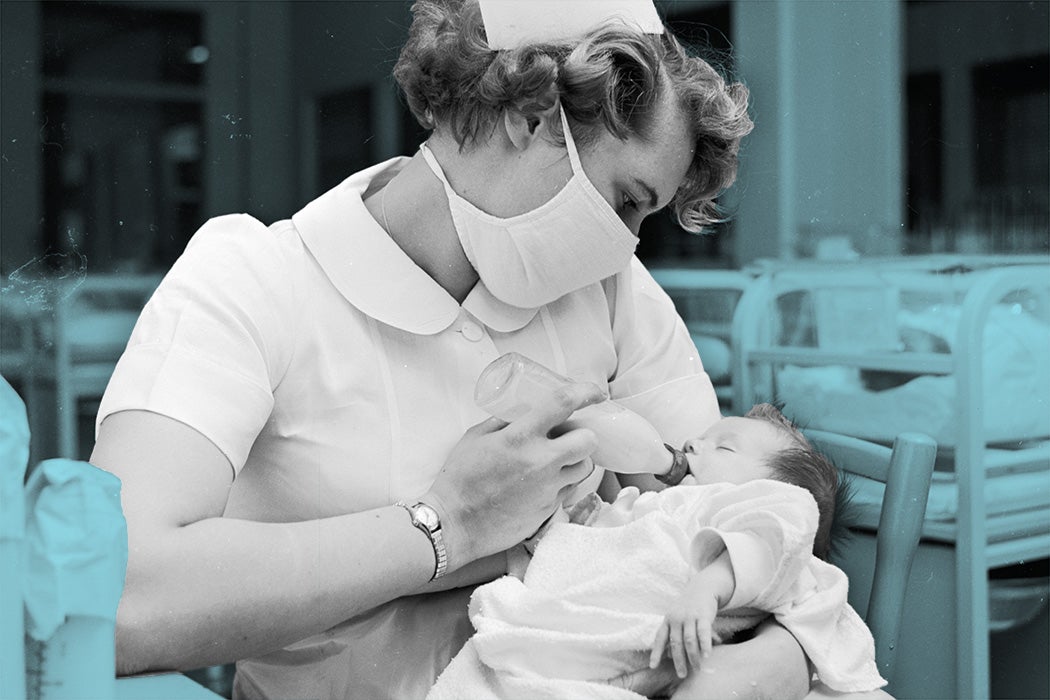Some newborn infants can’t cope with baby formula. They need human breast milk. If their mother is unable to produce it, she has to turn to another source. Enter the milk bank, a supply house of breast milk donated by other mothers.
Milk banks aren’t new, but they’ve waxed and waned in popularity. Research by scholars Mathilde Cohen and Hannah Ryan demonstrates the development, disappearance, and resurgence of milk banks in New York over the past century. By studying the records of milk banks in the first half of the twentieth century, they discovered that lactation has been both commodified and industrialized. The milk bank represented a continuity in the long human history of wet nursing, yet it’s not a widely discussed subject. As Cohen and Ryan note, “The practices of giving, selling, exchanging, and transporting human milk have a long, yet often unknown, history, and are now making a positive return.”
With the medicalization of reproductive health in the early 1900s came the regimentation of milk supplies, with male doctors rationalizing the ancient culture of taking milk from donors and supplying it to babies in need. Thus the “feminine, domestic practice of breastfeeding [was] transformed into a safer, disembodied, ‘product,’ made and prescribed by male physicians.” Breast milk would be tested, treated, and augmented to create the correct formula for each baby.
The donors were subject to control and surveillance of their diets and lifestyles, their employment contingent on capricious rules. Nonetheless, it was a financial opportunity for some, a paycheck for women at the bottom of the economic ladder. As Cohen and Ryan explain, “One feminist bent to milk banking in the early days was the idea that women could legitimately profit from their reproductive labor by selling their milk.” In the records, they found one woman in 1940 earning the equivalent of $16,000 per year by supplying the New York milk bank.
However, the increasing popularity of commercial baby formula since the 1950s, and later concerns around the HIV/AIDS epidemic, meant that by the 1980s, milk banking services had dwindled across the country. This led to a shortage for babies who need human milk, with the few states that still had these services forced to ship product around the country. In 2016, The New York Milk Bank was established, almost half a century after the closure of the last bank in the state.
The New York Milk Bank operates under different assumptions than the milk banks established in the early twentieth century, write Cohen and Ryan. The former were led by men, while The New York Milk Bank today is a woman-led enterprise. The founders entered a partnership with the Sirens, a female motorcycle club, to assist with delivery of the milk. The Sirens pick it up (packed in dry ice in courier bags) and deliver it to babies across the state.
There’s also been a transition in the socioeconomic status of the women supplying milk banks. A century ago, donors were more likely to be uneducated, working class, or recent immigrants. Today, donors are disproportionately educated and high earning. The New York Milk Bank donors are also not compensated. Donation is an altruistic gesture.
Weekly Newsletter
The authors describe the transition to “giftification” as reflecting shifts in women’s workforce participation, as well as cultural trends in breastfeeding. As they explain, “college-educated, white middle-class women became those more likely to breastfeed and donate their excess milk.” This is partly a result of their employment situations being more likely to offer opportunities to pump and maintain milk production. Women who pump to keep up supply are also more likely to end up with an excess that’s available for donation. This too reflects a broader change in maternity culture: modern pumps, and refrigeration, have enabled women who work away from home to continue breastfeeding.
It’s worth noting that the altruism model finds a parallel in blood donation, where it’s been demonstrated that paying donors can create a moral hazard of incentivizing potentially risky donations, a concern increased in the public mind since the appearance of HIV. Nonetheless, for milk, the donation model plays into historic understanding of motherhood, in which mothers are “socially constructed as selfless, altruistic, and maternal beings who lie beyond the realm of the productive, market economy.”
The New York Milk Bank, as an exchange of embodied product of motherhood, reflects a different economy than the one that drove early milk banks, one of women supporting one another.







